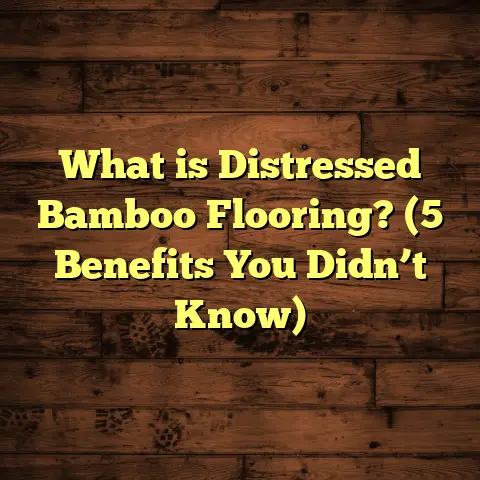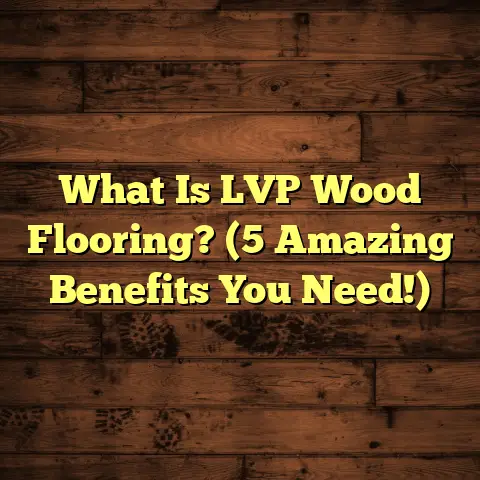What is Vinyl Flooring? (5 Reasons to Upgrade Your Space!)
Have you ever stood in your home, staring at your worn-out floors, and thought, “There has to be a better way to upgrade this space without spending a fortune or waiting weeks to get it done”? I’ve been there too. When I started working as a flooring contractor, vinyl flooring was one of those options I was initially unsure about. I’d heard people say it was cheap or not durable enough. But that all changed after I installed vinyl in multiple homes and watched it perform over time. It’s a flooring solution that’s worth a closer look if you want a balance of affordability, style, and practicality.
What is Vinyl Flooring?
Let’s break down what vinyl flooring really is. At its core, vinyl flooring is a synthetic material made from polyvinyl chloride (PVC) resin. It usually comes in three forms: sheets, tiles, or planks. The surface is printed with designs that can mimic natural materials such as hardwood, stone, ceramic tile, or even abstract patterns.
Vinyl flooring has been around since the mid-20th century but has evolved dramatically. Early vinyl floors were often thin and prone to damage. Today’s vinyl floors are engineered with multiple layers for durability and comfort:
- Backing layer: This provides stability and protects the floor from moisture underneath.
- Core layer: Often made from vinyl composite material (VCM) that adds strength.
- Printed design layer: High-resolution images printed on vinyl film create realistic textures.
- Wear layer: A transparent protective coating that guards against scratches, stains, and fading.
Thanks to advancements in printing technology and materials science, vinyl flooring looks far more sophisticated than it did decades ago. The patterns are so detailed that it’s tough to tell them apart from real hardwood or stone unless you get very close.
Types of Vinyl Flooring
I’m often asked which type of vinyl flooring is best. Here’s a quick rundown:
- Sheet Vinyl: Comes in large rolls, ideal for kitchens and bathrooms because it creates a seamless surface that resists water.
- Vinyl Tiles: Square tiles that snap or glue down. They’re great for DIYers who want to create custom layouts.
- Luxury Vinyl Planks (LVP): Designed to look like wood planks with texture and grain. LVP is thicker and more durable than standard vinyl tiles.
- Luxury Vinyl Tile (LVT): Mimics stone or ceramic tile with realistic texture and embossing.
Choosing between these depends on your room size, budget, and aesthetic preferences.
Why Vinyl Flooring? 5 Reasons to Upgrade Your Space
1. Durability That Lasts
In my early days as a flooring contractor, I installed hardwood floors for many clients who loved their beauty but struggled with maintenance and damage issues. Then I tried vinyl in a client’s playroom where kids were constantly dropping toys or spilling drinks. Years later, that vinyl floor looked as good as new while the hardwood floors in other rooms showed dents and scratches.
Vinyl floors are incredibly durable because of their layered construction. The wear layer resists scratches from pet claws or furniture movement. Plus, vinyl doesn’t chip or crack like ceramic tile can.
According to data from the North American Flooring Association, modern vinyl floors can last 10 to 20 years under normal household use — rivaling many hardwoods and laminates. And with today’s high-quality wear layers up to 20 mils thick (a mil is 1/1000th of an inch), you get excellent protection against daily wear.
2. Waterproof and Moisture-Resistant
One of the biggest advantages I’ve found with vinyl flooring is its resistance to water damage. Hardwood floors can warp or buckle when exposed to moisture. Tile grout lines can get dirty and cracked over time. But vinyl’s waterproof nature makes it ideal for rooms where spills, humidity, or flooding might occur.
I had one project where a family’s basement flooded after heavy rain. They were worried about expensive water damage repairs. We installed luxury vinyl planks with a waterproof core. After several minor floods since then, their floor remained intact with no swelling or mold issues.
Vinyl’s water resistance comes from its PVC composition and sealed seams (especially in sheet vinyl). Some luxury vinyl planks also have an attached underlayment that adds moisture protection beneath the floor.
3. Easy Installation Saves Time and Money
If you’ve ever seen how long hardwood or tile installation takes, you know it can be a major hassle—cutting individual pieces precisely, waiting for adhesives or grout to dry, dealing with dust and noise.
Vinyl flooring installation is often much quicker and cleaner. I frequently use click-lock luxury vinyl planks that snap together like puzzle pieces without glue or nails. This means no drying time and less mess.
For smaller rooms (around 200 sq ft), I can install vinyl floors in just one day—sometimes just a few hours if the subfloor is ready. This speed saves labor costs and gets families back into their space faster.
When planning projects, I use tools like FloorTally to figure out how much material I need and calculate costs accurately. This avoids wasting materials or underestimating expenses—a common problem in flooring projects.
4. Comfort Underfoot
One thing that surprised me early on was how comfortable vinyl flooring feels compared to tile or hardwood. It has a slight cushion due to its flexible layers, making it easier on feet and joints.
For elderly clients or anyone who spends hours standing in the kitchen, this makes a big difference in comfort. One couple I worked with told me they noticed less foot fatigue after switching from ceramic tile to luxury vinyl plank flooring.
Additionally, some vinyl comes with attached underlayment that adds sound dampening and insulation against cold concrete subfloors—perfect for basements or apartments.
5. Stylish Looks Without the Price Tag
People often think you have to spend thousands on hardwood or natural stone to get beautiful floors. Vinyl has changed that perception drastically.
With high-definition printing technology, luxury vinyl planks now replicate every detail of wood grain—from knots to color variations—and even textured embossing that mimics real wood feel underfoot.
I had one client who wanted the look of exotic Brazilian cherry hardwood but couldn’t afford it. We installed luxury vinyl planks with an almost identical appearance at less than half the cost per square foot.
Plus, vinyl offers endless design flexibility beyond wood looks—think marble patterns for bathrooms or fun geometric shapes for kids’ rooms.
Practical Uses for Vinyl Flooring
When helping homeowners choose flooring, I always consider where the floor will go because usage demands vary widely.
- Kitchens: Vinyl handles spills well and stands up to dropped utensils without chipping.
- Bathrooms: Its waterproof surface prevents mold growth unlike grout lines in tile.
- Basements: Resists moisture better than wood or laminate options.
- Entryways & Mudrooms: Tough against dirt tracked in from outside.
- Commercial Spaces: Easy cleaning suits busy retail or office environments.
Because vinyl can be installed over existing floors (as long as the surface is smooth), it’s a great choice when you want to avoid demolition mess.
Installation Tips from My Experience
If you decide on vinyl flooring yourself or hire someone like me, here are some practical tips I’ve learned over years:
- Prepare the Subfloor Carefully: The secret to a flawless vinyl installation is a clean, flat subfloor free from bumps or debris.
- Acclimate Your Flooring: Bring your vinyl planks or sheets into the room 48 hours before installation so they adjust to the temperature and humidity.
- Plan Your Layout: Start laying planks from the center of the room or longest wall for best visual balance.
- Cut Accurately: Use a sharp utility knife for sheet vinyl; a fine-toothed saw works well for planks.
- Leave Expansion Gaps: Vinyl expands slightly with heat changes—leaving small gaps at room edges prevents buckling.
- Follow Adhesive Instructions: Some types require glue; others are floating floors that click together without glue.
Overlooking these details can cause bubbles, gaps, or uneven surfaces that shorten your floor’s lifespan.
Maintenance Made Simple
One of the reasons I recommend vinyl flooring so often is how little upkeep it needs compared to other floors.
- Sweep or vacuum regularly to remove grit that can scratch the wear layer.
- Mop occasionally with warm water and mild detergent—avoid abrasive cleaners or bleach.
- Quickly wipe up spills to avoid staining.
- Place felt pads under furniture legs to prevent dents.
- Avoid standing water pooling on seams for extended periods.
A client of mine has had their vinyl kitchen floor for over eight years with just simple weekly cleaning—still looks brand new!
Cost Considerations & How FloorTally Helps Me
Budgeting for flooring projects can be tricky if you don’t have reliable data on prices for materials and labor in your area.
Vinyl flooring prices vary widely based on quality and style:
- Basic sheet vinyl can cost as little as $2 per square foot.
- Luxury vinyl planks typically range from $3 to $7 per square foot.
- Installation labor usually adds $1.50–$3 per square foot depending on complexity.
I use FloorTally regularly because it helps me input room dimensions, material choices, labor rates, and waste percentages all in one place. The tool generates accurate estimates quickly so I can plan projects with clients confidently.
Having clear cost projections upfront helps avoid surprises down the road—especially when working within tight budgets.
Unique Insights: Trends & Innovations in Vinyl Flooring
What keeps me excited about vinyl is how it continues improving year after year:
- Luxury Vinyl Tile (LVT) now offers thicker wear layers (up to 28 mils) providing commercial-grade durability suitable for busy homes.
- New embossing techniques create even more texture realism—some planks feel almost identical to real wood beneath your feet.
- Environmentally conscious options include phthalate-free products (reducing harmful chemicals) and recycled-content bases.
- Digital printing advancements allow for custom designs tailored exactly to client tastes—something unheard of just a decade ago.
My research shows vinyl flooring sales have grown steadily by around 25% annually in residential markets over recent years—proof it’s becoming a preferred choice across demographics.
Real-Life Case Studies: Vinyl Flooring Success Stories
Case Study 1: Family Basement Renovation
This family wanted a warm feel in their basement but worried about moisture damage from occasional leaks. We went with waterproof luxury vinyl planks featuring an attached underlayment for sound dampening.
After two years, they reported zero issues with swelling or damage despite minor flooding incidents under windows during storms. They loved how cozy the space felt compared to cold concrete floors before.
Case Study 2: Busy Kitchen Remodel
A couple with two young kids needed new kitchen floors that could handle constant spills and traffic without frequent repairs. We installed sheet vinyl with contemporary marble designs that looked elegant yet practical.
They appreciated how fast installation was (just one day) and how easy cleaning became after switching from tile grout lines that trapped food debris.
Case Study 3: Small Business Retail Shop
A boutique clothing store wanted stylish floors that wouldn’t break the bank but needed heavy-duty durability for daily foot traffic. Luxury vinyl tile in stone patterns gave them professional-looking floors resistant to scratches.
The owner mentioned how little maintenance was required compared to their previous carpeted floor which had frequent stains.
Personal Stories & Lessons Learned
Over the years, I’ve learned some valuable lessons working with vinyl flooring:
- Always communicate clearly with clients about expectations regarding texture and appearance; photos don’t always capture subtle differences well.
- Don’t underestimate prep work—it makes all the difference between smooth installations vs problems later.
- Trust reputable brands with thicker wear layers; cheap vinyl might save money upfront but won’t last as long.
- Encourage clients to think about lifestyle factors like pets, kids, and moisture exposure before choosing styles.
- Use digital tools like FloorTally for precise estimates—this builds trust and helps avoid project delays caused by unexpected costs.
One memorable moment was installing luxury vinyl plank in a single mom’s apartment while her kids played nearby. She told me how relieved she felt knowing her floor could handle spills and rough play without needing constant repairs—the perfect combination of durability and style for her busy life.
Final Thoughts: Is Vinyl Flooring Right for You?
If you want floors that:
- Handle daily wear without showing damage
- Resist moisture better than wood or laminate
- Install quickly without major disruption
- Feel comfortable underfoot
- Offer beautiful design options without high cost
Then vinyl flooring deserves serious consideration.
It’s not just an affordable alternative; it’s become a versatile solution that fits many lifestyles—from families with kids and pets to busy professionals needing easy maintenance.
So next time you think about upgrading your floors, ask yourself what matters most: style? Durability? Comfort? Price? Chances are good that vinyl flooring checks all those boxes—and then some.
Have questions about choosing the right type or installation tips? Want me to break down costs based on your room size? Just ask—I’m happy to share everything I’ve learned working hands-on with vinyl floors across countless projects!





